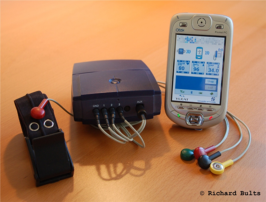As part of Remote Monitoring and Treatment, this research area deals with the application of mobile and wireless technologies, together with Body Area Networks, in order to provide mobile health services to patients and health professionals. Telemedicine services include remote monitoring and treatment services for patients with chronic conditions or in acute care (healthcare domain) and applications in preventative medicine such as support for lifestyle management (health and wellbeing domain).
BANs. Our definition of a Body Area Network is a network of devices worn on, in, or around the body which communicate with each other via (wireless or wired) communication links and cooperate together to provide mobile services to the user. When these services relate to healthcare or health and wellbeing we call these BANs health BANs.

BAN devices may be any body-worn devices (including implants) which have a communication interface. The devices of a health BAN may include medical devices such as biosensors but may also include non-medical devices used for medical purposes (such as a GPS device used to locate the patient when a medical emergency is detected). BAN devices used to date in our projects include
pulse oxymeter, temperature and respiration sensors, electrodes to measure ECG and sEMG, activity monitors (step-counter, 3D accelerometer); actuators (eg. to provide tactile feedback by means of vibration), multimedia devices (cameras and audio devices) and other devices such as GPS devices and alarm buttons. In addition, our BAN architecture includes one special device which combines the functions of communication gateway, processing platform and local data storage. Known in the generic BAN architecture as the MBU (Mobile Base Unit), the MBU functions have been implemented on a variety of hardware platforms (various PDAs and mobile phones from different manufacturers) under various mobile operating systems including Windows Mobile and Android.

BAN Services and Applications. Some examples are: telemonitoring of patients with atrial fibrillation or women with complications of pregnancy; or teletreatment for chronic pain patients. BAN applications are implemented by integrating the appropriate sensors and other devices into the BAN and by developing a software application to run locally on the BAN (ie on the MBU) or on a remote server, or a combination of the two. Local execution on the BAN itself brings all the well-known challenges relating to mobile platforms including limited processing power, memory and battery life. Remote execution, involving long range wireless communications, solves some of these problems but brings other challenges relating to the distributed environment, such as timing and synchronisation issues, and how to deal with delay, data loss and link loss in networks. And in all cases, we face the challenges of ensuring data security and integrity, protection of privacy and verification of correctness of operation (essential for patient safety in safety critical health applications) in the distributed environment. In most cases, BAN applications are implemented using a combination of local and remote processing so raising many research challenges.
Scaling up of telemedicine services is seen as a necessity since healthcare services worldwide are facing a crisis of provision over the coming years due to increasing demand (eg. because of the greying population) set against dwindling (human) resources. Telemedicine, ehealth and mhealth, together with patient self-management supported by ICT, are widely seen as an essential part of the solution for future health care delivery.
Clinical Decision Support Systems (CDSSs). However, large scale implementation of ICT supported homecare will generate huge amounts of monitoring and context data. This data cannot be scrutinised 24/7 by health professionals, so it needs to be screened by intelligent software systems. This calls for intelligent automated interpretation in real time of the data of each individual patient, including BAN data together with context data, the patient’s EMR and the treatment plan, in the light of medical knowledge. Our aim is to make telemedicine systems more intelligent and autonomous by integrating Clinical Decision Support. A CDSS is a knowledge-based ICT system which supports the clinical process, especially at the time and place where knowledge is needed to aid the task of decision making. Clinical Decision Support Systems, like any Knowledge Based Systems, apply inferencing mechanisms to validated domain knowledge together with patient-specific data. Our CDSS must be able to accept and reason about real time streaming biosignals and context data from the BAN as well as the (slower changing) medical data about the patient and his current and past problems from the EMR and other sources. The system must interpret and then act on the interpretation in a safe and dependable way, giving support, advice, feedback, perhaps even intervention, and explanation of reasoning to the patient. The system must also be able to justify its line of reasoning (eg to the health professional) by reference to clinical evidence and best practice.
Evidence-based Medicine. We investigate how to utilize medical knowledge from clinical protocols and clnical practice guidelines. This knowledge must be encoded into a formalism that the chosen inferencing mechanisms can operate on. That step of converting the expert knowledge sources into various formalisms is just one of the steps which must be verified to make sure that the semantics are preserved and that there are no omissions or inconsistencies in the knowledge base.

Staff
<list of the staff involved>
Publications
Publications by Val Jones (EEMCS)
Student Reports
BSc Report S. Lentelink: Healthy weight game!



